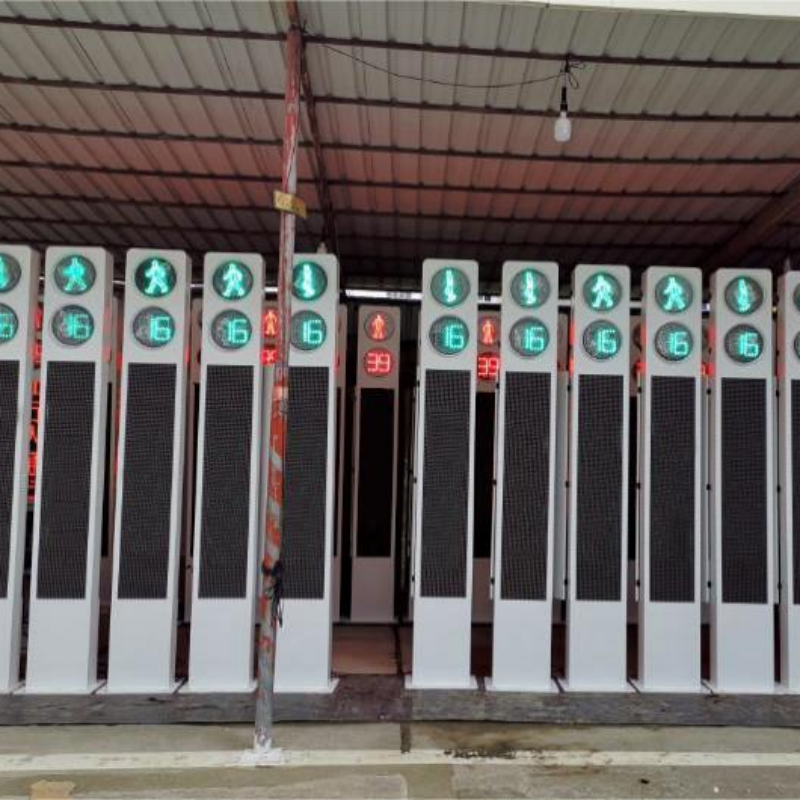Installation method of all in one pedestrian signal light directly affects the quality and performance of the product. Strictly installing the equipment in accordance with the standards can ensure that your product is successfully put into use. Signal light factory Qixiang hopes this article can help you make more informed decisions in your project.
1. Installation method and foundation requirements
Diversity of installation methods
Different installation scenarios require different installation methods. Common ones are flange installation and embedded parts installation. Flange installation is more flexible and simple, and is suitable for installation on hardened ground such as urban roads and squares. It fixes the all in one pedestrian signal light to the flange on the ground with bolts. The installation process is relatively fast, and if it needs to be relocated, it is also convenient to disassemble. The embedded parts installation is to embed the connector in advance when pouring the concrete foundation on the ground. This method makes the connection between the all in one pedestrian signal light and the foundation more secure. It is generally used in places with extremely high stability requirements, such as areas next to highways or by the sea that are susceptible to large external forces.
Foundation size and bearing capacity
The size and bearing capacity of the all in one pedestrian signal light foundation are directly related to stability. The size of the foundation needs to be determined based on height, weight, and local geological conditions. For example, in areas with softer soil, a larger and more stable foundation is needed to prevent tilting. The bearing capacity of the foundation should be able to withstand the weight of the all in one pedestrian signal light itself, the weight of the monitoring equipment, and additional loads such as wind loads and earthquake forces that may be encountered. Generally speaking, the concrete strength grade of the foundation should not be lower than C20, and the foundation depth should be ensured to meet the requirements to provide sufficient anti-overturning capacity.
2. Wind resistance and environmental adaptability
Wind resistance design
Compared with the square cross-section all in one pedestrian signal light, under the same conditions, the wind resistance coefficient is smaller and can better resist strong winds. At the same time, the structural design of the all in one pedestrian signal light should consider the wind pressure distribution, reasonably set up structures such as reinforcement ribs, and improve its bending strength. Some high-quality all in one pedestrian signal lights will also undergo wind tunnel tests to verify whether their wind resistance meets the standards.
Environmental adaptability
The all in one pedestrian signal light needs to have good wind resistance, especially in coastal areas or windy mountainous areas. Factors such as shape and cross-sectional size will affect its wind resistance. For example, in addition to wind resistance, the polygonal cross-section all-in-one pedestrian signal light must also consider adaptability under different environmental conditions. In harsh environments such as high temperature, low temperature, humidity, and high salt fog, the material and surface treatment of the all-in-one pedestrian signal light are crucial. If it is in a high humidity environment, it should have good moisture resistance to prevent internal rust; in coastal areas with salt fog, it is necessary to use highly corrosion-resistant materials or special anti-corrosion coatings, such as hot-dip galvanizing followed by powder spraying and other surface treatment processes to extend the service life of the all-in-one pedestrian signal light.
3. Wiring convenience and internal space
Wiring channel
The all-in-one pedestrian signal light should have a reasonable wiring channel inside to facilitate the laying of signal lines, power lines, etc. A good wiring channel can avoid line confusion and reduce the probability of line failure. The channel should be spacious enough to accommodate multiple cables, and there should be certain protection measures to prevent the cables from being squeezed and worn. For example, a PVC pipe or metal cable trough is set inside the all-in-one pedestrian signal light as a cable protection channel, and a sealing device is set at the entrance and exit of the channel to prevent rainwater, dust, etc. from entering.
The size and layout of the interior space of the all in one pedestrian signal light are also important. Sufficient interior space can easily place some small equipment, such as signal amplifiers, power adapters, etc. The space layout should be reasonable to facilitate the installation and maintenance of the equipment. For example, equipment mounting brackets and access ports should be set at appropriate locations of the all in one pedestrian signal light so that technicians can easily install and debug the equipment.
4. Coordination between appearance and surrounding environment
Color matching
The color of the all in one pedestrian signal light should match the surrounding environment. In urban streets and building areas, neutral colors such as silver gray and black are generally selected, so that the all in one pedestrian signal light does not appear abrupt. In natural landscape areas, such as parks and forests, colors that blend with the natural environment, such as green and brown, can be selected to allow the all in one pedestrian signal light to better integrate into the environment.
Styling style
The styling style of the all in one pedestrian signal light should also take into account the surrounding environment. In modern commercial areas or high-tech parks, simple and technological designs are more appropriate; in historical and cultural blocks or ancient building protection areas, the design of all-in-one pedestrian signal lights should be as simple and simple as possible to avoid conflicts with traditional architectural styles in order to maintain the visual coordination of the entire area.
Post time: Mar-14-2025







